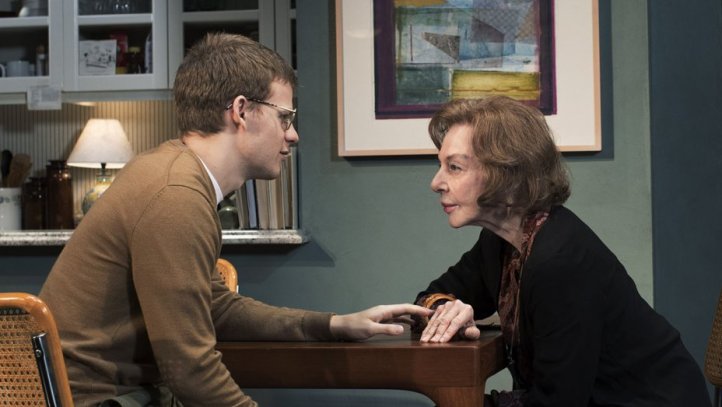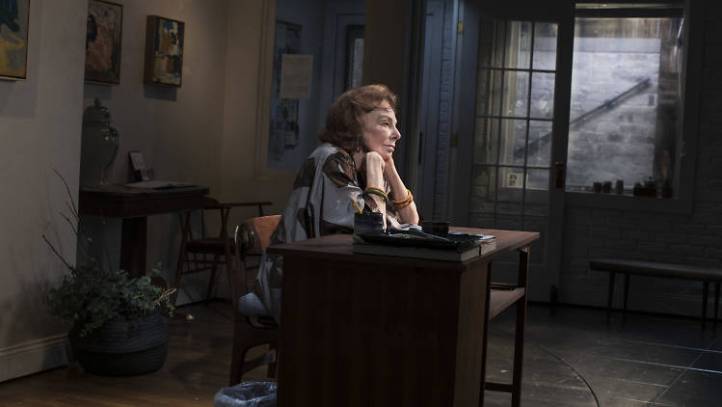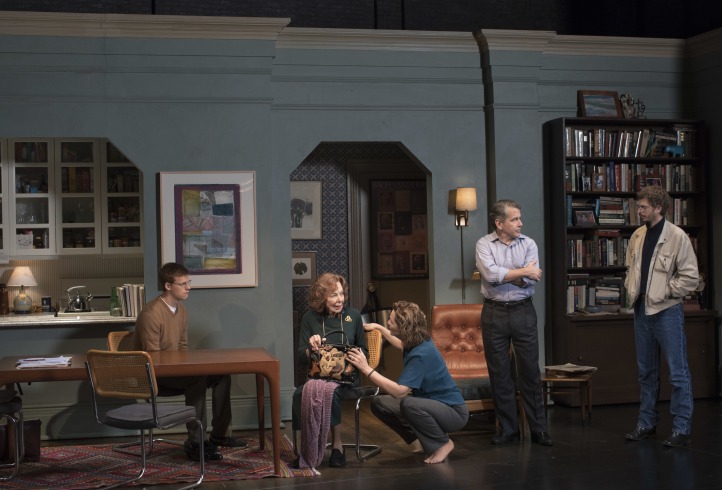
The Review: Kenneth Lonergan’s The Waverly Gallery
By Ross
The Waverly Gallery, as written by the generally solid Kenneth Lonergan (Lobby Hero, This is Our Youth) is a hard portrait to paint. It’s a quiet and detailed creation; a memory play about aging and memory loss, anchored by the untethered, magnetic and hypnotic Elaine May (“A New Leaf“) as the sweet but fading elderly gallery owner, mother, and grandmother, Gladys Green. May is astounding in the role, surrounded by a mish-mash of characterizations and personality types oddly created and structured. May carries the emotional heart, like a professional senile captain, growing into someone we truly can care for, even while acknowledging the difficulties that must surge up being around her character for too long. This schizm is perfectly drawn in the kind and gentle opening scene with her grandson, Daniel Reed, played haphazardly by the usually detailed Lucas Hedges (MCC’s Yen, “Manchester by the Sea“), as they sit sharing a moment of mismatched connection in the gallery on Waverly that is, in many ways, her secondary home. It’s clear he isn’t required to be there, but he wants to, as she rattles on, sweetly, mis-hearing words and answers, fiddling with her hearing aid, much to her grandson’s growing slight irritation. She is loved, that is obvious, and cared about deeply by this young man, the surrounding family we are about to meet, and by us, slowly and deeply over the course of the play, but it requires patience and a heap of understanding. Both for her, and for this slightly off-putting play.

Pivotal but problematic is the Hedges’ grandson role. It’s clear he is the stand-in for the playwright, but he’s given some pretty heavy-handed monologues that he delivers a bit too plainly to the audience. They drag the actor down, making it harder to connect with his caring interactions to his greatly loved but faltering grandmother. Those confessionals seem unnecessary, as our connection to the two happens even in spite of these awkward derailments. The heart-breaking attachments to her and her grandson sneak up on us, slowly taking hold and making us feel for both their dilemmas and the complications that comes along with this journey. The doorbell ringing in the night fortify the collapse, forcing us to question our own levels of difficult care to the edges. We watch with a pain in our heart as the drama of what was once a sharp and kind mind, slowly smashes in on itself, scattering into a million pieces of confusion and paranoid behavior. The scenes entrap as much as Gladys does to her family and her grandson with her non-stop kind queries and sentimental comments. It’s all very touching, but somehow slightly drifting, as the internal steady drive is slow and non-consequential. It connects because the sad end is obvious, but it’s dulled by the awkward distractions within the dialogue and brushstrokes.

So we must just wait and watch, much like this New York family gathering for a traditional weekly dinner. They teeter somewhere between love, caring, and tolerating, just barely, Gladys and her non-stop chatter. Stuck inside the beautifully detailed and magically changeable set creations, courtesy of quick-change magician David Zinn (Broadway’s The Humans), gorgeous distracting projections by Tal Yarden (Broadway’s Indecent), detailed costuming by Ann Roth (Broadway’s Three Tall Women), subtle lighting by Brian MacDevitt (Broadway’s Carousel), and solid sound by Leon Rothenberg (Broadway’s The Boys in the Band), this beautifully edgy, slightly cool, book-educated family take on the task with a strong sense of responsibility and purpose. Lonergam allows the fractures to, most authentically, occur, splintering patience and love in all directions. He delicately and oddly at times balances a family who are at a loss of what to do or how to deal. The complications only ratchet up higher and more personally disturbing when the gallery gets sucked up by the never-ending revamping of high-end Manhattan into boutique hotels and fancy breakfast cafes. Deep within the Fine Family, the authentic and brittle interactions deliver forward delicately nuanced performances, especially Gladys’ daughter Ellen, played purposefully by the glorious Joan Allen (Broadway’s The Heidi Chronicles, Burn This), wife of Howard who is portrayed with simplicity of purpose by David Cromer (director/the character, Stage Manager in Barrow Street’s Our Town). She’s at the end of her rope after years of engaging with a woman and mother that seems to be nothing like herself. The mother and daughter clearly never really found much common ground, but the trembling love is there, that’s obvious. It resides deeply, and sometimes authentically invisible at moments of high frustration and persistent meaningless conversation. “I’m going to blow my brains out“, she cries as the questions and the repetitions grow and the babble increases from one scene to the next forcing her to exit the space, dying to find peacefulness, but knowing the cost of that peace will be huge.

It’s deeply caring, this painting of dementia, but there’s a lot of muddle in the canvas at The Waverly Gallery to navigate. The dialogue veers towards awkward and out-of-place for no apparent reason or purpose. May’s Gladys is a magnificent gift to us all, demanding our attention to her fine performance with simplicity and honor. But I’m not quite sure the purpose of so many of the disjointed scenes that almost knock this gentle portrait off the wall, other than to just simmer in the details of a loved one’s descent. Don Bowman, the struggling oddball painter and delusional artist that wanders in and finds a homey place inside Gladys’ caring heart and gallery talks about trying to always represent the intricate details of real life within his paintings that eventually get hung on the gallery’s walls. It’s a beautifully simple metaphor that feels perfectly sculpted for the piece, although Don, played awkwardly by Michael Cera (Lobby Hero) feels too oddly created and written that one wonders what he is there for overall, beyond that metaphor and other moments of clarity into the grandmother’s decent. He stands there, clearly an outsider from this family although invited in, never knowing really what to say, and when he does, it feels like it’s floating in from another play. He’s sort of a stand-in for us, not really knowing how to help or be involved in this tragedy, but not wanting to abandon or discard this wonderfully kind woman. It’s clear that Gladys means a great deal to her grandson and holds a special place in the heart of Lonergan. The ending registers, despite all the clumsy brushstrokes, giving us a painting that is filled with sorrow and sadness, but clearly The Waverly Gallery shouldn’t remain hung too long on the wall next to all the other masterpieces of Lonergan’s. But maybe, it should go on May’s, who deliveries artistry and professionalism with every sweet twitch and kind confusing question.

[…] by Aaron Copp (Tanglewood’s Candide) and sound design by Leon Rothenberg (Broadway’s The Waverly Gallery), celebrating all that is wondrous about The New One and Mike Birbiglia’s adventure within […]
LikeLike
[…] Ivo Van Hove, and the brilliant craftmanship of video designer Tal Yarden (Broadway’s The Waverly Gallery, Indecent) rises magnificently center stage like a triumphant King Lear (or King Kong for that […]
LikeLike
[…] The Waverly Gallery Written by Kenneth Lonergan Directed by Lila Neugebauer John Golden Theatre Produced by Scott Rudin, Eli Bush, The John Gore Organization, Columbia Live Stage, Len Blavatnik, Universal Theatrical Group, Stephanie P. McClelland, James L. Nederlander, Eric Falkenstein, Suzanne Grant, Benjamin Lowy, Tulchin Bartner Productions, Peter May, Al Nocciolino, Patty Baker, Bob Boyett, Wendy Federman, Barbara H. Freitag, Heni Koenigsberg, David Mirvish, True Love Productions, Roxanne Seeman & Jamie deRoy, Jason Blum and The Shubert Organization (Philip J. Smith: Chairman; Robert E. Wankel: President) […]
LikeLike
[…] 1987 at Theatre 890 directed by Marshall W. Mason, with a cast that featured such powerhouses as Joan Allen, John Malkovich, Jonathan Hogan, and Lou Liberatore. That production sits in my mind as one of […]
LikeLike
[…] OUTSTANDING REVIVAL OF A PLAY (Broadway or Off-Broadway) All My Sons By the Way, Meet Vera Stark Juno and the Paycock Our Lady of 121st Street The Waverly Gallery […]
LikeLike
[…] Lady of 121st Street, Signature Theatre Summer and Smoke, Classic Stage Company/Transport Group The Waverly Gallery Uncle Vanya, Hunter Theater Project Outstanding Revival of a Musical Carmen Jones, Classic Stage […]
LikeLike
[…] OUTSTANDING ACTRESS IN A PLAY: Elaine May – The Waverly Gallery […]
LikeLike
[…] Hedges, Elaine May. The Waverly Gallery Photo by Brigitte […]
LikeLike
[…] in Adam Rapp’s The Sound Inside. Directed by phenomenal David Cromer (Broadway’s The Waverly Gallery) , the engaging Will Hochman (CSC’s Dead Poets Society), making his Broadway debut, […]
LikeLike
[…] Honoré (CSC’s Carmen Jones), a concise sound design by Leon Rotherberg (Broadway’s The Waverly Gallery), and simple symbolic costuming by Toni-Leslie James (Broadway’s Come From Away), and as the […]
LikeLike
[…] New York City Center Stage I. Directed with a tender finesse by Lila Neugebauer (Broadway’s The Waverly Gallery), the deconstructed layerings, an act Stephens (Heisenberg, Sea Wall) is so good at creating, of […]
LikeLike
[…] us, with the saddened Vanya, played by Tony-winning director David Cromer (Broadway’s The Waverly Gallery), moving through the space as if the weight of that air is as heavy as his soul. The portrayal […]
LikeLike
[…] reformation, as directed with a side-eyed glance of authenticity by Lila Neugebauer (Broadway’s The Waverly Gallery), the piece finds its way, steadfast and true into the delicious and angry dysfunction that exists […]
LikeLike